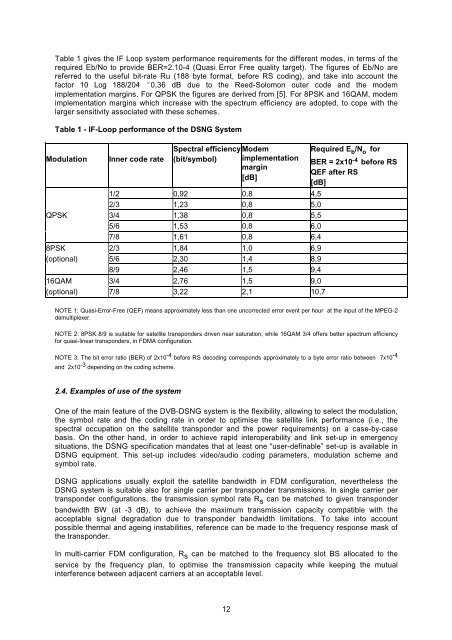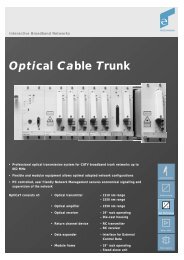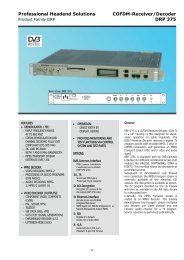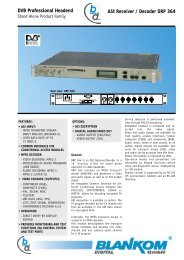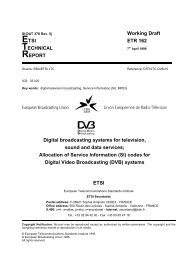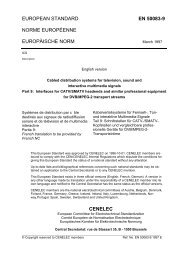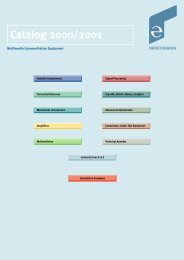Digital Video Broadcasting (DVB); User guidelines for Digital ...
Digital Video Broadcasting (DVB); User guidelines for Digital ...
Digital Video Broadcasting (DVB); User guidelines for Digital ...
Create successful ePaper yourself
Turn your PDF publications into a flip-book with our unique Google optimized e-Paper software.
Table 1 gives the IF Loop system per<strong>for</strong>mance requirements <strong>for</strong> the different modes, in terms of the<br />
required Eb/No to provide BER=2.10-4 (Quasi Error Free quality target). The figures of Eb/No are<br />
referred to the useful bit-rate Ru (188 byte <strong>for</strong>mat, be<strong>for</strong>e RS coding), and take into account the<br />
factor 10 Log 188/204 ˜0,36 dB due to the Reed-Solomon outer code and the modem<br />
implementation margins. For QPSK the figures are derived from [5]. For 8PSK and 16QAM, modem<br />
implementation margins which increase with the spectrum efficiency are adopted, to cope with the<br />
larger sensitivity associated with these schemes.<br />
Table 1 - IF-Loop per<strong>for</strong>mance of the DSNG System<br />
Modulation Inner code rate<br />
Spectral efficiency Modem<br />
(bit/symbol) implementation<br />
margin<br />
[dB]<br />
1/2 0,92 0,8 4,5<br />
2/3 1,23 0,8 5,0<br />
QPSK 3/4 1,38 0,8 5,5<br />
5/6 1,53 0,8 6,0<br />
7/8 1,61 0,8 6,4<br />
8PSK 2/3 1,84 1,0 6,9<br />
(optional) 5/6 2,30 1,4 8,9<br />
8/9 2,46 1,5 9,4<br />
16QAM 3/4 2,76 1,5 9,0<br />
(optional) 7/8 3,22 2,1 10,7<br />
12<br />
Required E b /N o <strong>for</strong><br />
BER = 2x10 -4 be<strong>for</strong>e RS<br />
QEF after RS<br />
[dB]<br />
NOTE 1: Quasi-Error-Free (QEF) means approximately less than one uncorrected error event per hour at the input of the MPEG-2<br />
demultiplexer.<br />
NOTE 2: 8PSK 8/9 is suitable <strong>for</strong> satellite transponders driven near saturation, while 16QAM 3/4 offers better spectrum efficiency<br />
<strong>for</strong> quasi-linear transponders, in FDMA configuration.<br />
NOTE 3: The bit error ratio (BER) of 2x10 -4 be<strong>for</strong>e RS decoding corresponds approximately to a byte error ratio between 7x10 -4<br />
and 2x10 -3 depending on the coding scheme.<br />
2.4. Examples of use of the system<br />
One of the main feature of the <strong>DVB</strong>-DSNG system is the flexibility, allowing to select the modulation,<br />
the symbol rate and the coding rate in order to optimise the satellite link per<strong>for</strong>mance (i.e., the<br />
spectral occupation on the satellite transponder and the power requirements) on a case-by-case<br />
basis. On the other hand, in order to achieve rapid interoperability and link set-up in emergency<br />
situations, the DSNG specification mandates that at least one “user-definable” set-up is available in<br />
DSNG equipment. This set-up includes video/audio coding parameters, modulation scheme and<br />
symbol rate.<br />
DSNG applications usually exploit the satellite bandwidth in FDM configuration, nevertheless the<br />
DSNG system is suitable also <strong>for</strong> single carrier per transponder transmissions. In single carrier per<br />
transponder configurations, the transmission symbol rate R s can be matched to given transponder<br />
bandwidth BW (at -3 dB), to achieve the maximum transmission capacity compatible with the<br />
acceptable signal degradation due to transponder bandwidth limitations. To take into account<br />
possible thermal and ageing instabilities, reference can be made to the frequency response mask of<br />
the transponder.<br />
In multi-carrier FDM configuration, R s can be matched to the frequency slot BS allocated to the<br />
service by the frequency plan, to optimise the transmission capacity while keeping the mutual<br />
interference between adjacent carriers at an acceptable level.


